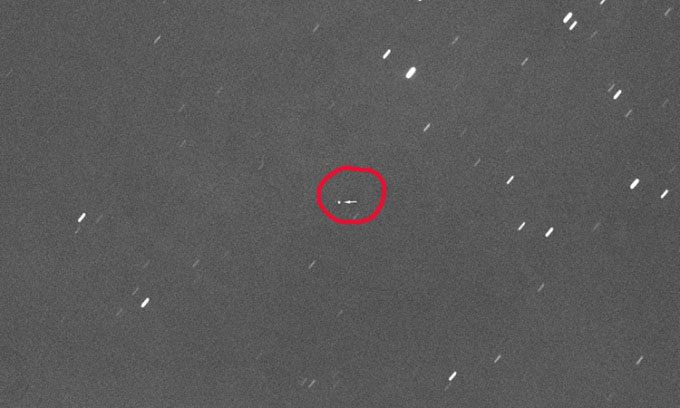The Orion spacecraft is nearing the end of its approximately 26-day flight, paving the way for NASA’s program to return humans to the Moon.
A research team from the Virtual Telescope Project in Italy captured images of Orion as it flew 382,000 km from Earth, roughly the average distance between Earth and the Moon, on December 7. The imaging process was quite complex due to the full moon phase, with the Moon shining brightly just 28 degrees away from the spacecraft.

NASA’s Orion spacecraft appears as a small dot (marked by an arrow) in the center of the photo. (Image: Virtual Telescope Project)
In the image, Orion is visible as a tiny dot in the center, surrounded by many stars that appear as short streaks. The telescope tracked the spacecraft for about 60 seconds, which is why the moving spacecraft looks like a dot while the stars remain static, resembling straight lines.
So far, Orion is functioning well. The Artemis I project team believes this success will continue until December 12, but they remain cautious. “We will not let our guard down. We still have some tough tasks ahead,” said Mike Sarafin, Artemis mission manager, during a press conference on December 8.
The return journey of Orion is one of the most challenging phases of the Artemis I mission. The spacecraft will plunge into the atmosphere at a speed of about 40,000 km/h, approximately 32 times the speed of sound. During re-entry, Orion will endure temperatures reaching up to 2,800 degrees Celsius – equivalent to half the heat of the Sun’s surface. The heat shield must protect the spacecraft’s components.
This will be a significant test for the heat shield – a completely new device that has never faced such extreme conditions. With a width of 5 meters, it is the largest heat shield of its kind. “There is no rocket or thermal facility on Earth capable of simulating the hypersonic re-entry process with such a large heat shield,” Sarafin stated.
Orion is scheduled to land in the Pacific Ocean off the coast of Baja California, Mexico, at 12:40 AM on December 12 (Hanoi time). This location is about 480 km south of the originally planned landing site (near San Diego). Experts changed the landing point to avoid bad weather.
The U.S. Navy ship USS Portland will be on standby to retrieve Orion and bring the spacecraft back to San Diego. Following this, the spacecraft will be transported to NASA’s Kennedy Space Center in Florida for a comprehensive post-flight inspection.


















































